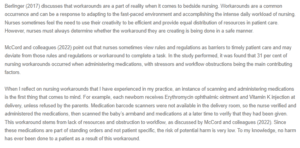Peer Response – Nursing Workarounds
Responding to Kaylee
Hello Kaylee,
Your insightful reflection on nursing workarounds resonates deeply with the realities of bedside nursing. Undeniably, workarounds are an integral part of the daily struggle for nurses to provide effective care, more so when working in a fast-paced and demanding setting. This necessitates that nurses have creative problem-solving skills to guarantee the equal distribution of resources while adapting to an ever-changing work environment. Your example of scanning and administering medications without barcode scanners in the delivery room highlights a common challenge nurses face. In such situations, the primary concern remains patient safety. It is reassuring to hear that this workaround hasn’t led to any harm. McCord and colleagues’ findings reveal a significant prevalence of workarounds during medication administration. These workarounds tend to occur more frequently when nurses face stressors and workflow obstructions (Jennings, 2021). Sometimes, rules and regulations act as obstacles that hinder nurses’ ability to deliver prompt care. Therefore, they resort to workarounds to effectively meet patients’ needs.
Healthcare organizations must address the root causes of workarounds. Investments in improved resources and technology play a vital role in reducing the necessity for such adaptations. Additionally, the optimization of processes further contributes to this reduction. Striking a balance between adherence to protocols and ensuring efficient and safe patient care remains the main goal in nursing practice. Your personal experience adds depth to this discussion. It sheds light on the complexities and challenges nurses face daily. It’s a testament to your commitment to patient safety and your ability to navigate the intricacies of healthcare delivery. When used thoughtfully with the patient’s best interests at heart, workarounds demonstrate the resilience and adaptability of nurses in healthcare. They are proof of the evolving nature of the field. Your perspective highlights the importance of continued dialogue and improvement in nursing practice. It will provide better support to both nurses and patients. Great work!
References
Jennings, B. M. (2021). Workflow, turbulence, and cognitive complexity. In Nurses contributions to quality health outcomes (pp. 85-107). Cham: Springer International Publishing. https://doi.org/10.1007/978-3-030-69063-2_5
ORDER A PLAGIARISM-FREE PAPER HERE
We’ll write everything from scratch
Question
Berlinger (2017) discusses that workarounds are a part of reality when it comes to bedside nursing. Workarounds are a common occurrence and can be a response to adapting to the fast-paced environment and accomplishing the intense daily workload of nursing. Nurses sometimes feel the need to use their creativity to be efficient and provide equal distribution of resources in patient care. However, nurses must always determine whether the workaround they are creating is being done in a safe manner.

Peer Response – Nursing Workarounds
McCord and colleagues (2022) point out that nurses sometimes view rules and regulations as barriers to timely patient care and may deviate from those rules and regulations or workaround to complete a task. In the study performed, it was found that 31 per cent of nursing workarounds occurred when administering medications, with stressors and workflow obstructions being the main contributing factors.
When I reflect on nursing workarounds that I have experienced in my practice, an instance of scanning and administering medications is the first thing that comes to mind. For example, each newborn receives Erythromycin ophthalmic ointment and Vitamin K injection at delivery, unless refused by the parents. Medication barcode scanners were not available in the delivery room, so the nurse verified and administered the medications, then scanned the baby’s armband and medications at a later time to verify that they had been given. This workaround stems from a lack of resources and obstruction to workflow, as discussed by McCord and colleagues (2022). Since these medications are part of standing orders and not patient-specific, the risk of potential harm is very low. To my knowledge, no harm has ever been done to a patient as a result of this workaround.
References
Berlinger, N. (2017). Workarounds are routinely used by nurses-But are they ethical? Examining the potential consequences of nurses’ improvised solutions and quick fixes. AJN American Journal of Nursing, 117(10), 53-55. https://doi.org/10.1097/01.NAJ.0000525875.82101.b7Links to an external site.
McCord, J. L., Lippincott, C. R., Abreu, E., & Schmer, C. (2022). A systematic review of nursing practice workarounds. Dimensions of Critical Care Nursing, 41(6), 347-356. https://doi.org/10.1097/DCC.0000000000000549Links to an external site.


